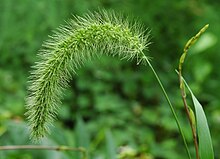
Poaceae or Gramineae is a large and nearly ubiquitous family of monocotyledonous flowering plants known as grasses. It includes the cereal grasses, bamboos and the grasses of natural grassland and species cultivated in lawns and pasture. The latter are commonly referred to collectively as grass.

Weed control is the botanical component of pest control, which attempts to stop weeds, especially noxious weeds, from competing with desired flora and fauna including domesticated plants and livestock, and in natural settings preventing non native species competing with native species.

Foxtail millet, scientific name Setaria italica, is an annual grass grown for human food. It is the second-most widely planted species of millet, and the most grown millet species in Asia. The oldest evidence of foxtail millet cultivation was found along the ancient course of the Yellow River in Cishan, China, carbon dated to be from around 8,000 years before present. Foxtail millet has also been grown in India since antiquity.
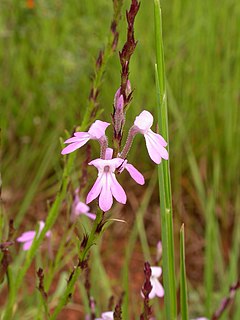
Striga, commonly known as witchweed, is a genus of parasitic plants that occur naturally in parts of Africa, Asia, and Australia. It is in the family Orobanchaceae. Some species are serious pathogens of cereal crops, with the greatest effects being in savanna agriculture in Africa. It also causes considerable crop losses in other regions, including other tropical and subtropical crops in its native range and in the Americas.

In agriculture, a living mulch is a cover crop interplanted or undersown with a main crop, and intended to serve the purposes of a mulch, such as weed suppression and regulation of soil temperature. Living mulches grow for a long time with the main crops, whereas cover crops are incorporated into the soil or killed with herbicides.

Abutilon theophrasti is an annual plant in the family Malvaceae, native to southern Asia. Its specific epithet theophrasti commemorates the ancient Greek botanist-philosopher Theophrastus. Abutilon theophrasti is the type species of the genus Abutilon.
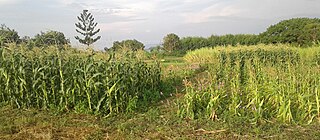
Push–pull technology is an intercropping strategy for controlling agricultural pests by using repellent "push" plants and trap "pull" plants. For example, cereal crops like maize or sorghum are often infested by stem borers. Grasses planted around the perimeter of the crop attract and trap the pests, whereas other plants, like Desmodium, planted between the rows of maize, repel the pests and control the parasitic plant Striga. Push–pull technology was developed at the International Centre of Insect Physiology and Ecology (ICIPE) in Kenya in collaboration with Rothamsted Research, UK. and national partners. This technology has been taught to smallholder farmers through collaborations with universities, NGOs and national research organizations.

Thlaspi arvense, known by the common name field pennycress, is a flowering plant in the cabbage family Brassicaceae.

Hordeum jubatum, with common names foxtail barley, bobtail barley, squirreltail barley, and intermediate barley, is a perennial plant species in the grass family Poaceae. It occurs wild mainly in northern North America and adjacent northeastern Siberia. However, as it escaped often from gardens it can be found worldwide in areas with temperate to warm climates, and is considered a weed in many countries. The species is a polyploid and originated via hybridization of an East Asian Hordeum species with a close but extinct relative of Californian H. brachyantherum. It is grown as an ornamental plant for its attractive inflorescences and when done flowering for its infructescence.

Setaria is a widespread genus of plants in the grass family.
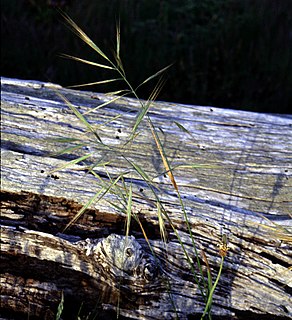
Bromus diandrus is a species of grass known by the common names great brome and "ripgut brome".

Amaranthus tuberculatus, commonly known as roughfruit amaranth, rough-fruited water-hemp, tall waterhemp, or common waterhemp, is a species of flowering plant. It is a summer annual broadleaf with a germination period that lasts several months. Tall waterhemp has been reported as a weed in 40 of 50 U.S. states.

Carthamus lanatus is a species of thistle known as woolly distaff thistle, downy safflower or saffron thistle. It is closely related to safflower, which is in the same genus. This annual plant is a native of the Mediterranean Basin, but it is familiar in other places where it was introduced and has become a noxious weed, such as in parts of North America and southern Australia with similar climates.

Setaria pumila is a species of grass known by many common names, including yellow foxtail, yellow bristle-grass, pigeon grass, and cattail grass. It is native to Europe, but it is known throughout the world as a common weed. It grows in lawns, sidewalks, roadsides, cultivated fields, and many other places. This annual grass grows 20 centimetres to well over 1 metre in height, its mostly hairless stems ranging from green to purple-tinged in color. The leaf blades are hairless on the upper surfaces, twisting, and up to 30 centimetres long. The inflorescence is a stiff, cylindrical bundle of spikelets 2 to 15 centimetres long with short, blunt bristles. The panicle may appear yellow or yellow-tinged.

Setaria sphacelata is a tall African grass, also known as South African pigeon grass and African bristlegrass. It is native to tropical and subtropical Africa, and is extensively cultivated globally as a pasture grass and for cut fodder. This is a rhizomatous perennial grass producing flattened, hairless, blue-green stems up to 2 m tall. The inflorescence is a dense, narrow panicle of bristly, orange-tinged spikelets up to 25 cm long.

Setaria verticillata is a species of grass known by the common names hooked bristlegrass, rough bristle-grass and bristly foxtail. It is native to Europe, but it is known on most continents as an introduced species and often a noxious weed. It is a hardy bunchgrass which grows in many types of urban, cultivated, and disturbed habitat. It is a weed of many types of agricultural crops, growing in vineyards and fields. Herbicide-resistant strains have been noted.

Setaria viridis is a species of grass known by many common names, including green foxtail, green bristlegrass, and wild foxtail millet. It is sometimes considered a subspecies of Setaria italica. It is native to Eurasia, but it is known on most continents as an introduced species and is closely related to Setaria faberi, a noxious weed. It is a hardy grass which grows in many types of urban, cultivated, and disturbed habitat, including vacant lots, sidewalks, railroads, lawns, and at the margins of fields. It is the wild antecedent of the crop foxtail millet.
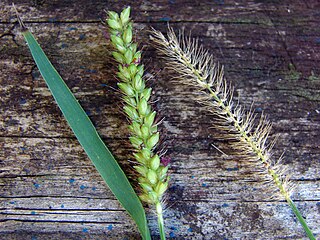
Setaria parviflora is a species of grass known by the common names marsh bristlegrass, knotroot bristle-grass, bristly foxtail and yellow bristlegrass. It is native to North America, including Mexico and the United States from California to the East Coast, Central America and the West Indies, and South America.

Setaria palmifolia is a species of grass known by the common names palmgrass, highland pitpit, hailans pitpit, short pitpit, broadleaved bristlegrass, and knotroot. In Spanish it is called pasto de palma and in Samoan vao 'ofe 'ofe. It is native to temperate and tropical Asia. It is known elsewhere as an introduced, and often invasive, species, including in Australia, New Zealand, many Pacific Islands, and the Americas.
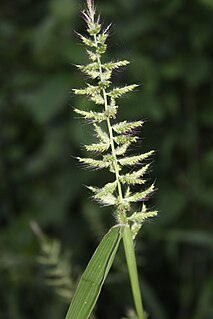
Setaria barbata, with common names bristly foxtail grass, corn grass, Mary grass, and East Indian bristlegrass, is a species of grass in the family Poaceae native to tropical Africa and tropical Asia.
